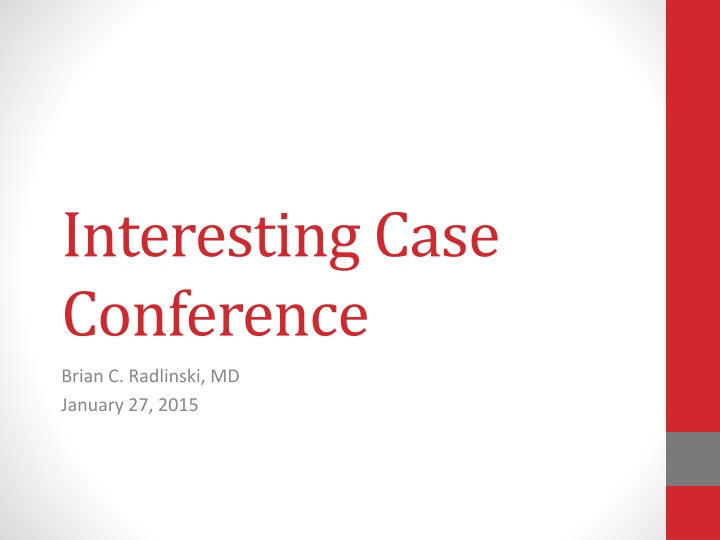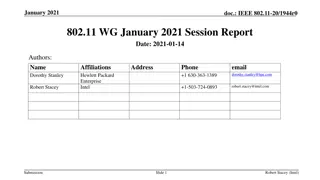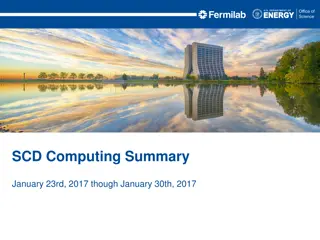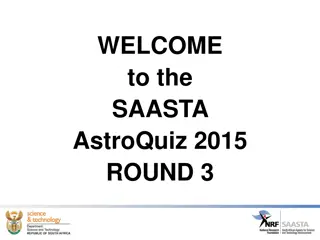Interesting Case Conference - Brian C. Radlinski, MD (January 27, 2015)
A detailed case conference discussing the clinical history, prior treatments, blood bank reports, and a delayed hemolytic transfusion reaction in a 43-year-old Caucasian female with systemic lupus erythematosus, end-stage renal disease, and multiple medical interventions. The presentation highlights significant events, including MSSA bacteremia, antibody profiles, blood transfusions, and potential complications related to immune responses. Various images depict the patient's journey and key findings throughout the medical timeline.
Download Presentation

Please find below an Image/Link to download the presentation.
The content on the website is provided AS IS for your information and personal use only. It may not be sold, licensed, or shared on other websites without obtaining consent from the author.If you encounter any issues during the download, it is possible that the publisher has removed the file from their server.
You are allowed to download the files provided on this website for personal or commercial use, subject to the condition that they are used lawfully. All files are the property of their respective owners.
The content on the website is provided AS IS for your information and personal use only. It may not be sold, licensed, or shared on other websites without obtaining consent from the author.
E N D
Presentation Transcript
Interesting Case Conference Brian C. Radlinski, MD January 27, 2015
Clinical History 43 y/o white F with SLE ESRD on HD CAD: MI and stents x 2 MR s/p MVR in 7/2013 AICD placement in 9/2014 Met. Multifocal PTC s/p thyroid resection in 10/2014 Chronic anemia: PCV 20-30% past 5+ yrs. 2 children, born in 2000 and 2002
Clinical History MSSA bacteremia in Nov.; removal of Vascath; tx. With cefazolin x 4 weeks; new tunneled L. subclavian line on 12/5 Presented to OSH on 12/10 with fever; MSSA bacteremia again; transferred to VUH on 12/12 AICD extracted on 12/15 and cefazolin restarted x 6 weeks; removal of tunneled line on 12/16; discharged on 12/23
Prior Tx. Hx. and Blood Bank Reports Positive DAT for IgG fixation with negative eluate since 2009 Never evidence of immune hemolysis 2 RBC units 7/2010 2 RBC units 8/2010; last negative Ab screen 3/2013: Fya Ab (plus DAT+); 2 RBC units thereafter 7/2013: E Ab (plus Fya Ab and DAT+); partial phenotype: C Ag+, E Ag-, Jka Ag-; 2 RBC units thereafter 1 RBC unit 10/9/14 11/15/14: Jka Ab (plus E Ab, Fya Ab, and DAT+); partial phenotype: Jka Ag-; 1 RBC unit thereafter
Blood Bank Report 12/15/14 H/o alloantibodies against Fya, E, and Jka; rec d RBC tx. s on 10/9/14 and 11/5/14 ABO type: A+ Ab Screen+, DAT 2+ for IgG and negative for complement Anti-s Ab identified in patient's plasma and the eluate Pt.'s RBCs previously tested by ARC and found to be s Ag- New clinically significant IgG antibody directed against the s antigen. This is consistent with a delayed serologic transfusion reaction
Delayed Transfusion Rxn. (DTR) Delayed hemolytic transfusion reaction (DHTR) Hemolysis occurs 24 hours to 28 days after transfusion (CDC) Anamnestic response: Exposure to non-self RBC Ag Ab formation but fades over time (if pt. not retested after tx., might never be known) re- exposure to Ag in future tx. (because Ab screen is negative) Anamnestic rapid production of IgG Ab vs. target Ag IgG Ab remove RBC in the liver/spleen = extravascular hemolysis NB: DHTRs due to Jk Ab may be intravascular and severe (can fix complement)
Delayed Transfusion Rxn. (DTR) Sg/sx: fever, mild jaundice/scleral icterus, back pain, hypotension, etc. Lab findings: anemia, elevated LDH and (indirect direct) bilirubin, decreased haptoglobin (even though extravascular), (micro)spherocytes on peripheral smear, DAT+ (classically mixed field ), newly identified allo-Ab Treatment: Often unnecessary (unless severe and intravascular, then treat as for an acute HTR)
Delayed Transfusion Rxn. (DTR) Delayed serologic transfusion reaction (DSTR) Presence of a new, clinically significant RBC Ab in a patient transfused between 24 hours and 28 days ago without evidence of that Ab at time of tx., AND Complete lack of evidence of hemolysis Don t diagnose DSTR without studying the patient carefully i.e., repeat Ab screen on pretransfusion sample if possible, evaluate bilirubin, haptoglobin, LDH, peripheral smear, etc. Blood group Ab associated with DTRs include Kidd, Duffy, Kell, and MNS, in order of decreasing frequency
Antigens of Pt.s Alloantibodies Antigen Prev. Chrom. System HDFN? HTR? Dosage Enzyme modifi- cation Fya 65% (W) 10% (B) 1 Duffy yes yes yes E 30% (W) 21% (B) 1 Rh Rare, mild yes yes Jka 77% (W) 91% (B) 18 Kidd yes yes yes s (little) 89% (W) 97% (B) 4 MNS yes yes yes
Donor Unit Compatibility This pt. has acquired Ab against Jka, E, Fya, and s. The probability of finding a donor unit negative for these Ag: 0.35 x 0.70 x 0.23 x 0.11 x 100 = 0.62% But pt. is A+, so can only receive A or O blood, which is 40% + 45% = 85% of donor population This decreases donor population to 85% of 0.62%, or 0.53% (or just 0.25% if matched for type A) Thus, number of units to crossmatch to find compatible unit: 1/0.0053 = 190 units, or 1/0.0025 = 403 units Pt. s RBCs have been phenotyped at ARC; clinicians aware that if transfusion anticipated, as much advance notice as possible is needed
References Centers for Disease Control and Prevention. National Healthcare Safety Network: Biovigilance Component Protocol. August 2014. http://www.cdc.gov/nhsn/PDFs/Biovigilance/BV- HV-protocol-current.pdf Chaffin, J. Blood Bank Guy. Last updated 2015. www.bbguy.org Harmening, DM. Modern Blood Banking and Transfusion Practices. 5thed. Philadelphia: F.A. Davis Company, 2005. Roback, JD et al. Technical Manual. 17thed. AABB, 2011.























